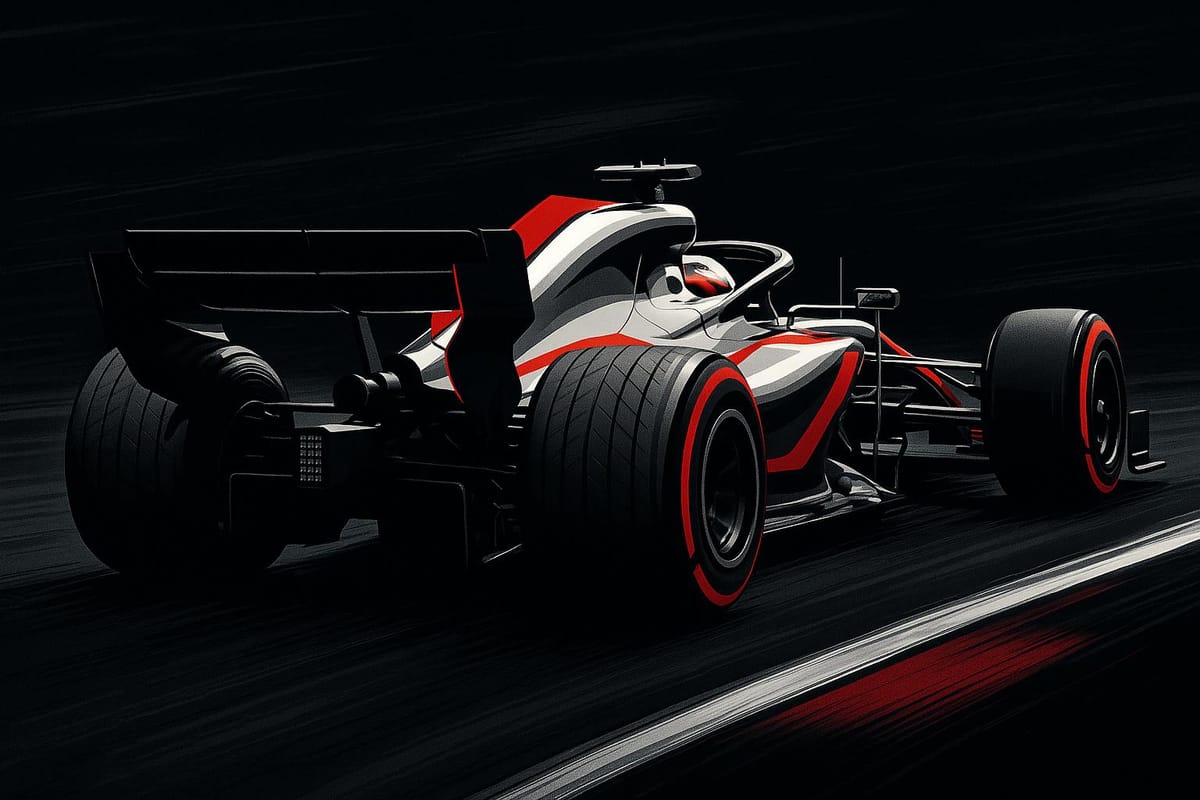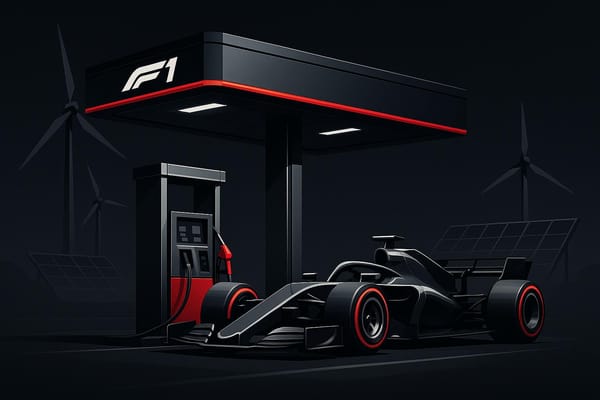Are F1 Cars Four Wheel Drive? What You Need to Know
F1 cars are not four-wheel drive; they rely on rear-wheel drive for performance, handling, and compliance with regulations. Learn why RWD is essential.

No, Formula 1 (F1) cars are not four-wheel drive (4WD). They use a rear-wheel drive (RWD) system, as mandated by FIA regulations. Here's why RWD is the standard and why 4WD isn't used in F1:
- FIA Rules: F1 cars must exclusively use RWD systems.
- Performance Benefits of RWD:
- Better weight distribution and handling during high-speed cornering.
- Simpler, lighter transmission systems improve aerodynamics and reduce power losses.
- Challenges with 4WD in F1:
- Adds weight, complicates aerodynamics, and disrupts handling.
- Past attempts, like the Ferguson P99 and Lotus 63, faced these issues and didn’t succeed long-term.
- Future Possibilities: Hybrid technology and energy recovery systems could introduce front-axle drive elements in the future, but full 4WD remains unlikely.
RWD remains dominant in F1 due to its unmatched balance, simplicity, and compliance with regulations. Keep reading for a deeper dive into why 4WD hasn’t worked in F1 and how hybrid systems might shape the future.
How a Formula 1 Race Car Works

Rear-Wheel Drive: The F1 Standard
Let’s dive into why rear-wheel drive (RWD) is the go-to choice for Formula One cars. In F1 design, power is sent exclusively to the rear wheels, a decision that maximizes weight distribution, improves aerodynamics, and sharpens handling. Beyond meeting FIA regulations, this setup brings a range of performance perks that make it indispensable on the track.
Why RWD Works in F1
RWD shines in Formula One because of how it manages traction and power. With the car’s weight naturally shifting toward the rear during acceleration, the rear wheels gain better grip, allowing drivers to unleash the car’s full potential, especially in high-speed corners. Plus, the simpler transmission layout of RWD helps keep the car’s center of gravity low, enhancing overall stability and balance.
The Role of FIA Regulations

The FIA mandates that all Formula One cars must use a rear-wheel-drive system. This rule ensures a level playing field while staying true to the sport's engineering philosophy.
| Aspect | RWD Advantage in F1 |
|---|---|
| Weight Management | Avoids the extra components needed for front-wheel drive, keeping the car lighter. |
| Handling Dynamics | Delivers exceptional control, especially during cornering at high speeds. |
| Aerodynamic Design | Simplifies the front-end, allowing for streamlined aerodynamics. |
| Mechanical Efficiency | Reduces power losses with a straightforward transmission system. |
Past 4WD Attempts in F1
Four-wheel drive (4WD) in Formula 1 may not have had a lasting impact, but it offered valuable lessons that shaped the sport’s approach to drivetrain technology. These early experiments highlighted why modern F1 cars remain firmly rear-wheel drive.
Ferguson P99: A Historic 4WD Triumph
The Ferguson P99 holds a special place in F1 history as the only 4WD car to ever win a Formula 1 race. Developed by Harry Ferguson's tractor company, the P99 was a showcase for 4WD innovation, featuring a 50-50 torque split and a front-engine layout.
"If I backed off the Ferguson did not instantly tighten into the corner. Instead it would simply decelerate...one had consciously to steer this car." – Stirling Moss
Its moment of glory came in 1961, when Stirling Moss piloted it to victory in wet conditions at the Oulton Park Gold Cup. Moss later described it as "the finest front-engined Formula 1 car of that time".
| Achievement | Details |
|---|---|
| Major Victory | 1961 Oulton Park Gold Cup |
| Total Race Record | 9 races: 1 win, 1 second place, 3 thirds |
| Engine Options | 1.5L or 2.5L Climax engine |
| Historical Significance | Last front-engined F1 car to win a race |
1969 Efforts: Lotus 63 and Matra MS84
In the late 1960s, teams like Lotus and Matra revisited 4WD technology. Both the Lotus 63 and Matra MS84 incorporated reversed DFV engines, custom Hewland gearboxes, and Ferguson 4WD systems. However, the added weight of these setups proved to be a major drawback. The Matra MS84, for instance, struggled with handling due to its increased mass.
Drivers were critical of these cars, with the Lotus 63 even being labeled a "death trap". The heavy front-end design made cornering particularly unstable, negating any theoretical advantage of 4WD.
The most notable performance came at the 1969 US Grand Prix, where Johnny Servoz-Gavin placed sixth in the Matra MS84. Ironically, this was achieved with the 4WD system disabled, marking the only time a 4WD F1 car scored championship points.
These experiments underscored the technical challenges of 4WD in F1, setting the stage for the sport’s continued reliance on rear-wheel drive systems in the years that followed.
4WD Technical Limitations in F1
Weight Penalties
In Formula 1, adding a four-wheel-drive (4WD) system introduces a significant weight problem. Components like front differentials, extra driveshafts, and transfer cases are necessary, but they all add bulk to a car that thrives on being as light as possible. F1 demands extreme weight efficiency, and even slight increases can have ripple effects on performance.
"It's the same trap F1 got itself into when it selected this engine. It seemed like a simple idea but when you started doing the engineering it became very, very complex… I think we have to be very careful before we say 'let's just throw a four-wheel-drive car out there,' because it could be another one of those ones where one team will probably hit a home run and the rest of us will be struggling with trying to catch up with that. I think simple's better." - Gene Haas
This added weight doesn’t just slow the car down on straights; it also increases tire wear, affects fuel consumption, and complicates race strategy. On top of that, the extra components required for 4WD can disrupt the car’s aerodynamics, which are critical to performance.
Aero Design Conflicts
Modern F1 cars are aerodynamic masterpieces, designed to generate immense downforce - around 750 kg - while keeping drag to a minimum. However, introducing 4WD components would interfere with this delicate balance. Here's how:
| Aerodynamic Element | Impact of 4WD Components |
|---|---|
| Front Wing | Could disrupt airflow critical for underbody performance |
| Underbody Tunnels | May be compromised by additional drivetrain hardware |
| Overall Efficiency | Likely to reduce the downforce-to-drag ratio |
These disruptions would force teams to redesign their cars’ aerodynamics, potentially diminishing the ground effect, which is essential for modern F1 performance.
Handling Drawbacks
Beyond weight and aerodynamic issues, 4WD systems historically created significant handling challenges. Past experiments with 4WD in F1 revealed that the added complexity often made cars unpredictable and difficult to control.
"The car's so heavy on the front, you turn into a corner and the whole thing starts driving you." - Jackie Stewart
"Death trap." - Graham Hill
These systems made the cars feel unbalanced, especially when cornering, and the supposed gains in mechanical grip were overshadowed by the loss of driver confidence. These issues underscore why F1 continues to rely on rear-wheel drive, which provides a more balanced and predictable driving experience.
4WD Possibilities in Modern F1
Hybrid Power and Front Axle Drive
Modern Formula 1 is venturing into new possibilities, exploring how hybrid technology might breathe life into the concept of four-wheel drive (4WD). With the planned removal of the MGU-H (Motor Generator Unit – Heat) in upcoming regulations, discussions are heating up around alternative ways to recover and deploy energy. Mercedes motorsport boss Toto Wolff weighed in on the matter:
"If there is an emphasis on maybe not having the MGU-H any more, the heat recovery any more, how do we compensate for 60 percent of electric energy that is being lost? There are various possibilities and front motors is one possibility. It's not that we are absolutely stuck on implementing front motors but we have to discuss all possible technologies that can compensate for the lack of power."
One of the ideas gaining traction is a front-axle KERS (Kinetic Energy Recovery System), which could pave the way for 4WD in F1. How? By:
- Recovering braking energy via the front wheels
- Storing that energy for strategic boosts
- Improving grip during cornering
- Enhancing the ability to race closely with competitors
These advancements in hybrid technology could significantly influence the sport, especially with the regulatory changes set for 2026.
2026 Power Unit Rules Impact
The 2026 regulations promise to reshape F1’s powertrain landscape, building on the potential of hybrid systems. Here’s how the power distribution is expected to shift:
| Power Source | Current Output | 2026 Output |
|---|---|---|
| ICE Power | 550–560 kW | 400 kW |
| Electric Power | 120 kW | 350 kW |
| Weight | - | 30 kg lighter |
Formula 1 CEO Stefano Domenicali highlighted the significance of these changes:
"These regulations mark a significant moment in the future of our sport as we look forward to a new generation of car and power unit that aims to give our fans closer and exciting racing."
The 2026 rules bring several key updates:
- Transition to 100% sustainable fuel
- A significant increase in electric power deployment, now up to 50%
- Enhanced Energy Recovery Systems, capable of delivering 350 kW
- Introduction of a "Manual Override Mode" to replace the traditional DRS system
These updates open the door for 4WD integration, but they also introduce challenges. Weight limitations and the added complexity of such systems must be carefully managed, especially under the sport's strict cost cap.
Conclusion: RWD Dominance in F1
Rear-wheel drive (RWD) remains the backbone of Formula One, driven by strict FIA regulations and its clear performance advantages. By channeling power exclusively to the rear wheels, RWD allows the front wheels to focus entirely on steering, delivering the precision and balance needed for high-speed cornering.
On the other hand, four-wheel drive (4WD) systems come with drawbacks that make them unsuitable for F1. The added weight of 4WD compromises performance, as history has shown in past attempts to integrate the technology. Additionally, the immense downforce generated by modern F1 cars negates any potential traction benefits that 4WD might bring.
RWD's dominance in F1 is a testament to its efficiency under the sport's technical framework. Its lighter build, mechanical straightforwardness, and unmatched handling capabilities ensure it remains at the heart of Formula One design, perfectly meeting both the FIA’s regulations and the demands of peak performance.
FAQs
Why are F1 cars required to use rear-wheel drive instead of four-wheel drive?
F1 cars are mandated to use rear-wheel drive due to FIA regulations aimed at ensuring fair competition, controlling costs, and achieving peak performance. This setup simplifies the drivetrain, cutting down on weight and mechanical complexity - key factors for maintaining the incredible speed and agility that Formula One demands.
Rear-wheel drive also plays a crucial role in enhancing how these cars handle. It provides better weight distribution and allows for precise control during high-speed cornering, a critical aspect of the sport’s technical challenges. By standardizing this requirement, the regulations also help teams manage development expenses, creating a more balanced competition across the grid.
Why didn’t four-wheel drive (4WD) cars succeed in Formula One?
Four-wheel drive (4WD) cars in Formula One struggled to find their footing due to several significant challenges. One of the biggest issues was the added weight of the 4WD system, which directly impacted speed and agility - both crucial for competitive racing. Every extra pound made the cars slower and less nimble, putting them at a disadvantage on the track.
Drivers also reported that 4WD cars were harder to handle. The system made the cars feel unpredictable and less responsive, which is far from ideal when precision and control are everything in Formula One.
At the same time, advancements in aerodynamics and tire technology were changing the game. Improved wings and better tires provided enough grip and downforce, effectively eliminating the need for 4WD systems. With these innovations offering more reliable performance benefits, the complexity and drawbacks of 4WD designs made them less appealing. As a result, 4WD systems faded into the background of Formula One history.
Could future F1 cars use four-wheel drive with hybrid technology?
It's possible that future F1 cars might incorporate four-wheel drive capabilities through advanced hybrid technology. One intriguing concept involves a front-axle KERS (Kinetic Energy Recovery System). This system would collect energy from braking at the front wheels, store it in batteries, and then use it later to provide additional power. Essentially, this could enable a form of four-wheel drive during energy deployment.
This approach is being considered as a way to compensate for energy losses if the MGU-H (Motor Generator Unit-Heat) is eventually removed from F1 power units. While no final decisions have been made, such developments could reshape how performance and efficiency are balanced in the sport.




